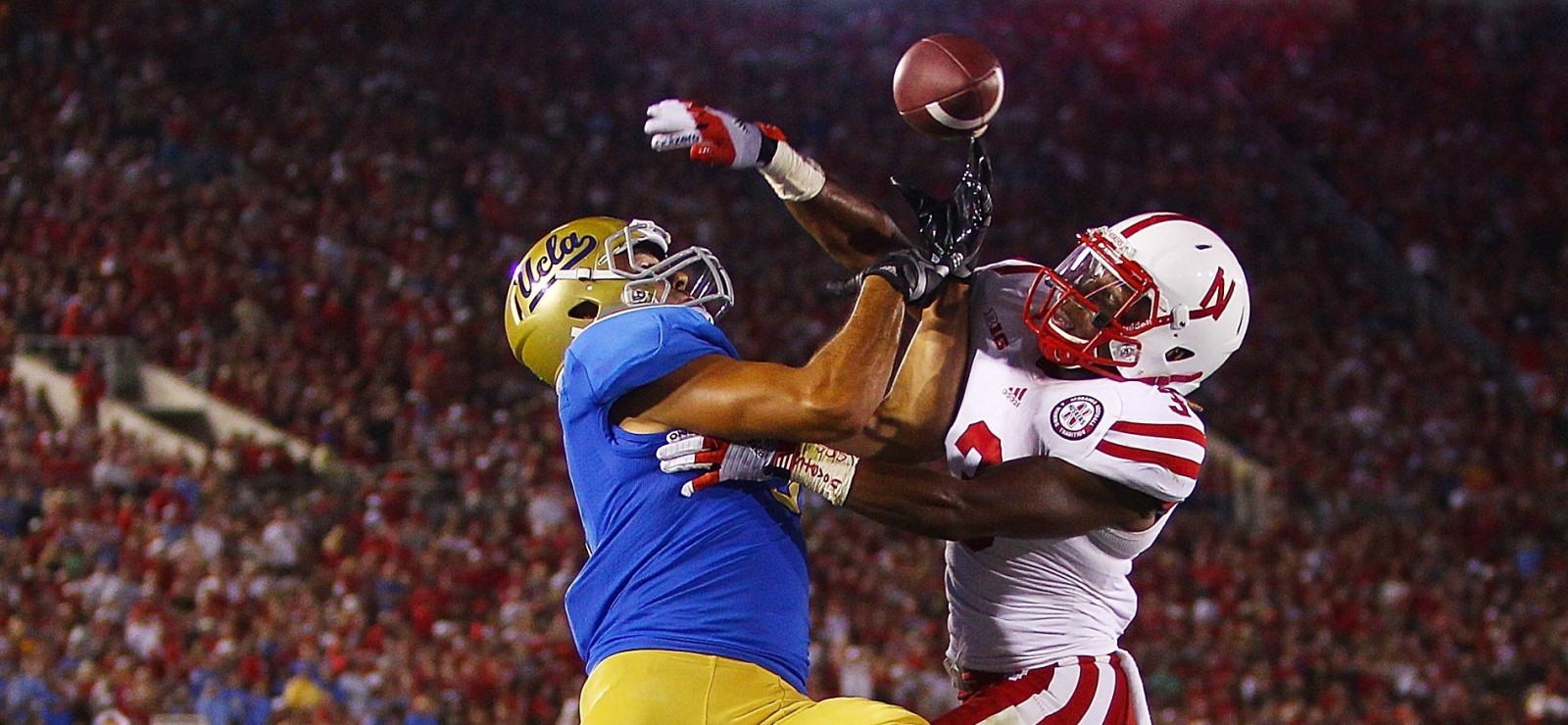UCLA and Nebraska Stars Provide Backbone For 49ers Championships
By Joe Hession
49ers Museum Historian
While the 1982 Nebraska Cornhuskers steamrolled to a Big 8 title and finished the season ranked third in the nation, and the 1982 UCLA Bruins grabbed a Pac-10 championship and a number 5 ranking, the San Francisco 49ers were defending their 1981 Super Bowl XVI championship.
Under the direction of team owner Edward DeBartolo Jr, head coach Bill Walsh and general manager John McVay the 49ers were looking to upgrade and reload after Super Bowl XVI. They went on to build one of the greatest dynasties in sports, winning five Super Bowls between 1981 and 1995. That championship run coincided with the arrival of several UCLA and Nebraska standouts, including three former Cornhuskers teammates from the 1982 roster: Roger Craig, Tom Rathman and Jamie Williams.
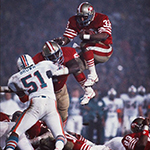 Roger Craig redefined the running back position after joining the 49ers as a second round draft pick in 1983 out of Nebraska. The high-stepping halfback was a natural fit for Bill Walsh’s West Coast Offense. Although rarely used as a receiver at Nebraska (16 collegiate receptions) the sure-handed Craig developed into one of quarterback Joe Montana’s favorite targets. In 1985 he became the first player in NFL history to gain 1,000 yards rushing and 1,000 yards receiving in the same season. Craig’s 92 receptions led the league in 1985 and he scored a team-high 15 touchdowns.
Roger Craig redefined the running back position after joining the 49ers as a second round draft pick in 1983 out of Nebraska. The high-stepping halfback was a natural fit for Bill Walsh’s West Coast Offense. Although rarely used as a receiver at Nebraska (16 collegiate receptions) the sure-handed Craig developed into one of quarterback Joe Montana’s favorite targets. In 1985 he became the first player in NFL history to gain 1,000 yards rushing and 1,000 yards receiving in the same season. Craig’s 92 receptions led the league in 1985 and he scored a team-high 15 touchdowns.
Craig also earned three Super Bowl rings as a 49ers player. At Super Bowl XXIII he made a strong case for MVP, catching eight passes for 101 yards against the Cincinnati Bengals and rushing for 71.
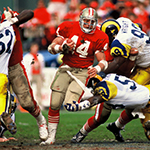 Tom Rathman (currently the 49ers running backs coach) joined Craig in the 49ers backfield in 1986 after San Francisco selected him in the third round of the NFL draft. During his senior season at Nebraska, Rathman averaged 7.5 yards per carry while rushing for 881 yards. Considered a hard-nosed blocking fullback, he caught just five passes as a Cornhusker. Rathman continued to be a punishing runner in the NFL, but in San Francisco’s West Coast Offense, he also developed into one of the best receiving backs in the game. He recorded 73 catches in 1989, second best on the team behind the incomparable Jerry Rice.
Tom Rathman (currently the 49ers running backs coach) joined Craig in the 49ers backfield in 1986 after San Francisco selected him in the third round of the NFL draft. During his senior season at Nebraska, Rathman averaged 7.5 yards per carry while rushing for 881 yards. Considered a hard-nosed blocking fullback, he caught just five passes as a Cornhusker. Rathman continued to be a punishing runner in the NFL, but in San Francisco’s West Coast Offense, he also developed into one of the best receiving backs in the game. He recorded 73 catches in 1989, second best on the team behind the incomparable Jerry Rice.
Rathman played on the 49ers Super Bowl champion XXIII and XXIV teams. He scored two rushing touchdowns at Super Bowl XXIV in the 49ers 55-10 rout of the Denver Broncos.
In a touch of irony, Rathman and Craig became the most prolific receiving backs in 49ers history. Although the two combined for just 21 catches at Nebraska, they finished their 49ers careers with 802 receptions between them.
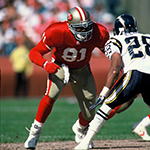 Tight end Jamie Williams, Craig’s former roommate at Nebraska, joined the 49ers prior to the 1989 season and promptly earned a Super Bowl ring as the 49ers closed out that campaign with a resounding victory over the Broncos. Williams contributed one catch at Super Bowl XXIV, but it helped maintain a crucial third quarter touchdown drive. Over the course of his five-year career in San Francisco, Williams proved to be a devastating blocker from the tight end position, often leading the way for his former Nebraska teammates, Craig and Rathman.
Tight end Jamie Williams, Craig’s former roommate at Nebraska, joined the 49ers prior to the 1989 season and promptly earned a Super Bowl ring as the 49ers closed out that campaign with a resounding victory over the Broncos. Williams contributed one catch at Super Bowl XXIV, but it helped maintain a crucial third quarter touchdown drive. Over the course of his five-year career in San Francisco, Williams proved to be a devastating blocker from the tight end position, often leading the way for his former Nebraska teammates, Craig and Rathman.
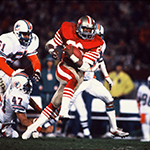 The UCLA Bruins contributed to the 49ers decade of dominance as well. Speedster Wendell Tyler was the 49ers dominant running back from 1983-1985. Prior to his NFL career, Tyler led UCLA to a 23-10 Rose Bowl win over Ohio State in 1976. He gained 172 yards in that game.
The UCLA Bruins contributed to the 49ers decade of dominance as well. Speedster Wendell Tyler was the 49ers dominant running back from 1983-1985. Prior to his NFL career, Tyler led UCLA to a 23-10 Rose Bowl win over Ohio State in 1976. He gained 172 yards in that game.
Tyler set a 49ers single-season rushing record (since broken) in 1984 with 1,262 yards, averaging over five yards per carry. When Craig came aboard he teamed with Tyler to provide the 49ers with the NFL’s most formidable duo. In 1984, the Tyler-Craig backfield combined for 2,816 rushing and receiving yards. Tyler earned his only championship ring that year as the 49ers beat Miami at Super Bowl XIX.
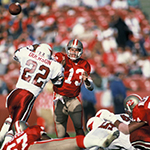 Former UCLA quarterback Steve Bono signed as a free agent with San Francisco in 1989 and earned a Super Bowl ring that season. Bono spent the 1989 and 1990 campaigns absorbing Walsh’s West Coast Offense and watching it being executed to perfection by future Hall of Fame quarterbacks Joe Montana and Steve Young. In 1991 Bono got his shot. After Montana and Young were sidelined with injuries, Bono took command of the 49ers offense for six games. He went 5-1 as the starting signal caller and finished the season as the NFL’s fourth rated passer.
Former UCLA quarterback Steve Bono signed as a free agent with San Francisco in 1989 and earned a Super Bowl ring that season. Bono spent the 1989 and 1990 campaigns absorbing Walsh’s West Coast Offense and watching it being executed to perfection by future Hall of Fame quarterbacks Joe Montana and Steve Young. In 1991 Bono got his shot. After Montana and Young were sidelined with injuries, Bono took command of the 49ers offense for six games. He went 5-1 as the starting signal caller and finished the season as the NFL’s fourth rated passer.
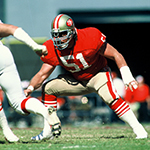 Offensive lineman Randy Cross paved the way for 49ers running backs for well over a decade. Selected in the second round of the 1976 NFL draft by San Francisco, the former UCLA All-America guard and center was a linchpin on the Bruins club that beat Ohio State in the 1976 Rose Bowl. In San Francisco he was the nucleus of a new era and was instrumental in the 49ers evolution from cellar dwellers to champions. Cross suffered through a pair of 2-14 seasons before hitting the Super Bowl jackpot. During his 13-year 49ers career he played on three championship teams winning Super Bowls XVI, XIX, and XXIII, and appeared in three Pro Bowls.
Offensive lineman Randy Cross paved the way for 49ers running backs for well over a decade. Selected in the second round of the 1976 NFL draft by San Francisco, the former UCLA All-America guard and center was a linchpin on the Bruins club that beat Ohio State in the 1976 Rose Bowl. In San Francisco he was the nucleus of a new era and was instrumental in the 49ers evolution from cellar dwellers to champions. Cross suffered through a pair of 2-14 seasons before hitting the Super Bowl jackpot. During his 13-year 49ers career he played on three championship teams winning Super Bowls XVI, XIX, and XXIII, and appeared in three Pro Bowls.
Most importantly, Cross went out a winner, retiring after Super Bowl XXIII. On the final plays of his 49ers career he was in the trenches as Montana led a dramatic late game drive and finished it with a last second scoring strike to John Taylor that beat the Bengals 20-16.
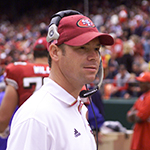 Bruins current head coach Jim Mora soaked in the finer points of championship football during a seven-year stint with San Francisco from 1997-2003. He spent his last five seasons in San Francisco as the 49ers defensive coordinator.
Bruins current head coach Jim Mora soaked in the finer points of championship football during a seven-year stint with San Francisco from 1997-2003. He spent his last five seasons in San Francisco as the 49ers defensive coordinator.
“Coach Mora talks a lot about his time with the 49ers, especially the team’s work ethic and commitment,” UCLA defensive lineman Matt Dickerson said. “I was always a big Jerry Rice fan. He was my favorite 49er growing up. Coach Mora told us about his drive to win and his grueling training techniques. Rice was one of the greatest players of all time and he was always trying to improve.”
Artifacts and memorabilia from many former UCLA and Nebraska football stars are on display in the 49ers Museum presented by Sony. Included are Tom Rathman’s complete game-worn uniform, five Lombardi Trophies and a Super Bowl ring from every 49ers championship team. Museum guests can also stroll through the life-sized 49ers Hall of Fame statues and a re-creation of Bill Walsh’s 49ers office, or watch interactive highlight videos of every 49ers season.
For more information on Museum tickets, hours and content, visit levisstadium.com/Museum. For group pricing call 415-GO-49ERS.

